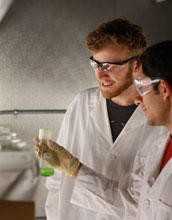All Images
News Release 12-157
Engineers Pursue Flexible Electronics, Self-folding Structures and Controlled Photosynthesis on a Grand Scale
Collaborative engineering awards will explore new frontiers to advance health care, manufacturing and energy
This material is available primarily for archival purposes. Telephone numbers or other contact information may be out of date; please see current contact information at media contacts.

The objective of the EFRI project led by Daniela Rus of MIT is to create computational materials whose properties can be programmed to achieve specific shapes and/or mechanical properties, such as stiffness, upon command. The new computational materials will integrate sensing, actuation, computation and communication. Beginning as flat structures with built-in, universal crease patterns, the materials will be capable of autonomously changing their geometric and mechanical configuration following new folding plans and control algorithms. The team will combine the materials and algorithms in a programmable, intelligent origami system capable of producing a range of different origami shapes to meet the design and engineering goals for the structure. By enabling the rapid design and fabrication of multi-functional engineered systems, the results of this research could transform the way we build machines.
Credit: Daniela Rus, MIT
Download the high-resolution JPG version of the image. (716 KB)
Use your mouse to right-click (Mac users may need to Ctrl-click) the link above and choose the option that will save the file or target to your computer.
A simple approach to self-folding of pre-stressed polymer sheets is demonstrated using local heat absorption on pre-defined hinges patterned by black ink from a desktop printer. Such work will be investigated further in an EFRI project led by Jan Genzer of NC State. His team will explore origami with polymer sheets that fold in response to light, creating new multi-functional 3-D structures that form rapidly into precisely controlled shapes. The polymer sheets will fold at hinges defined by inkjet printing--an approach that can be broadened to a range of 2-D patterning techniques, including screen-printing and lithography. The researchers will study and model the scaling laws of folding, the rate of folding, and the mechanics of folding to develop compliant folding mechanisms. With new understanding of materials and the use of external stimuli, the team will enhance control of folding to increase the functionality of the 3-D structure. This simple, versatile approach aims to lead to a novel paradigm for developing materials with unprecedented functions and properties.
Credit: Ying Liu, Julie Boyles, Michael Dickey, Jan Genzer, North Carolina State University

An EFRI project led by Greg Rorrer at Oregon State will harness the unique biosynthetic capacity of the diatom--a type of algae that extracts plentiful silicate from the ocean to create cell walls of nanostructured silica. Photosynthetic diatoms have the potential to make three diverse product streams: hydrocarbons for chemicals and fuels, the polymer chitin and its monomer glucosamine for biomedical and food applications and silica-based nanomaterials with a range of properties and applications. The team will design scalable systems for a future diatom-based photosynthetic biorefinery, and they will use life-cycle analysis and techno-economic analysis to assess its ultimate sustainability. Here, a light photomicrograph of the centric diatom Coscinodiscus wailessi shows its chloroplasts (green bodies) and silica pore structure.
Credit: Rorrer Laboratory, Oregon State University
Download the high-resolution JPG version of the image. (471 KB)
Use your mouse to right-click (Mac users may need to Ctrl-click) the link above and choose the option that will save the file or target to your computer.

SEES Fellow Andrew Markley (left) and graduate student Daniel Mendez-Perez examine a flask of cyanobacteria in the lab of Brian Pfleger at the University of Wisconsin-Madison. Pfleger's EFRI team will investigate biorefineries based on photosynthetic cyanobacteria (blue-green algae), examining the steps from genetic engineering to the industrial production of chemicals and fuels. The researchers will use their findings to update undergraduate courses in engineering economics, and they will provide research opportunities to teachers and high-school students.
Credit: Andrew Markeley, University of Wisconsin-Madison
Download the high-resolution JPG version of the image. (1.3 MB)
Use your mouse to right-click (Mac users may need to Ctrl-click) the link above and choose the option that will save the file or target to your computer.

The ideal microalgae species and cultivation practices for hydrocarbon biofuel production have yet to be found. To advance this goal, EFRI researchers led by Arum Han of Texas A&M will create a unique microfluidic "lab-on-a-chip" platform to finely analyze microalgae growth and behavior over time. Using the microfluidic platform, the researchers will rapidly screen a variety of microalgae under various growing conditions. The most promising microalgae strains will be evaluated at pilot-scale for hydrocarbon production and environmental factors.
Credit: Arum Han, Texas A&M University
Download the high-resolution JPG version of the image. (593 KB)
Use your mouse to right-click (Mac users may need to Ctrl-click) the link above and choose the option that will save the file or target to your computer.


